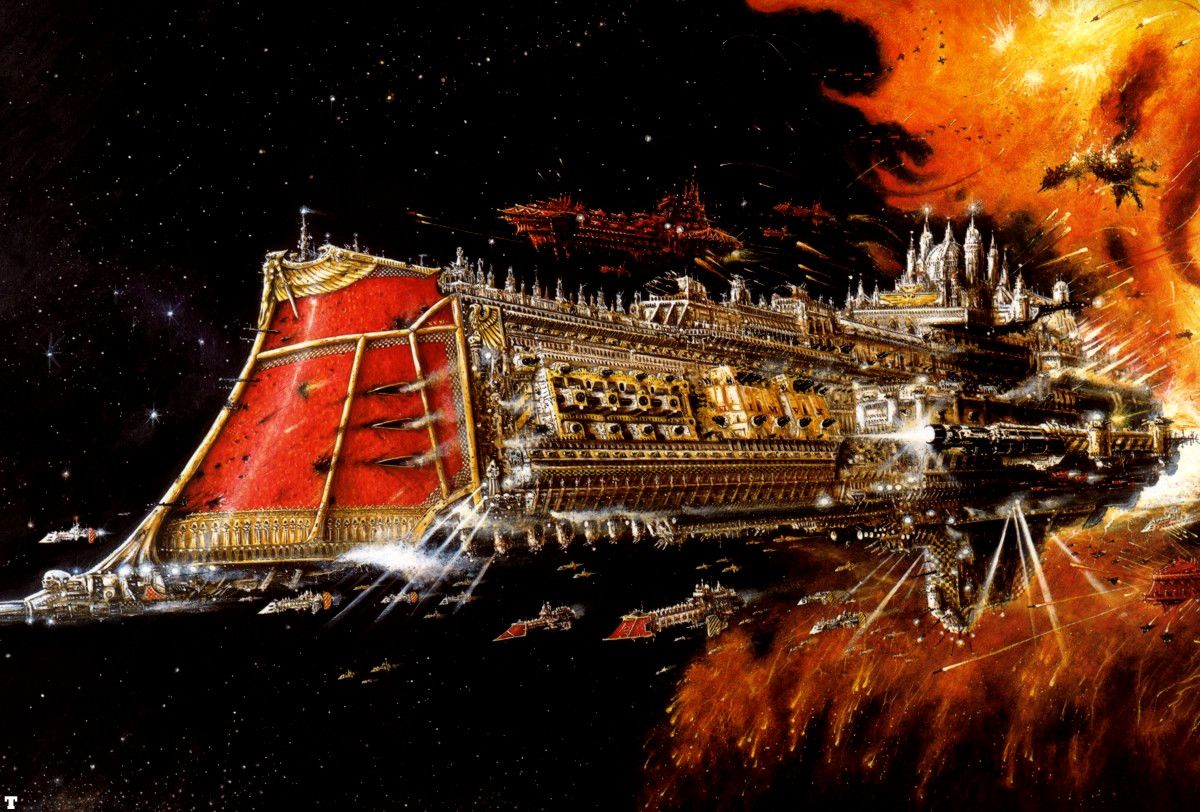In our first article we discussed what Battlefleet Gothic (BFG) is, how to find everything you need to play, and why you should play it (it’s the best and you become the best by association). Today we are going to focus on how to set up a fleet with the core fleets from the original game – the ships, how they play, and why you should play them. We will get to all the cool expansion ships and fleets in the next article before closing out this series with how to tie BFG into your 40k narratives. I’m joined by fellow contributor Charlie Brassley to discuss the Imperial Navy.
Forming Up The Fleet
Size of the Game
Battlefleet Gothic games may range from 500 to 2,500 for decent sized patrols all the way up to full fleet sized engagements. Common game sizes range between 1,250 and 2,000 points, but fair warning, Battlefleet Gothic does take a fair amount of time at the upper ranges of points values. As we mentioned in the first article, Battlescribe remains an excellent resource to quickly build your fleet for any point level – but bear in mind that the file will contain all expansion ships from not just the core book, but also the Armada book and various individual supplements. Any game of 750 points or more must include a fleet commander.
Leadership and Squadrons
Prior to the game, each ship and/or squadron rolls for leadership and applies any modifiers that are applicable. A commander may then take command of their chosen flagship. For the purposes of squadroning, escorts must be taken in mixed squadrons of 2-6 vessels, while capital ships may squadron based on their size – cruisers, heavy cruisers, and battlecruisers may be taken in a mixed squadron of 2-4 vessels, while grand cruisers and battleships may be taken in squadrons of 2-3 but not intermixed.
The Imperial Navy – Charlie B

Why You Should Play as the Imperial Navy
If Battlefleet Gothic is the Age of Sail in space, the Imperial Navy gives you the most iconic BFG experience. Everything from the figureheads on their backswept prows to the rows of broadside cannons feels extremely on brand, both for the game, and the Imperium in general. There’s an undeniable grandeur to a nicely painted Imperial fleet, and their ludicrously expansive roster of ships makes them one of the most flexible all-rounders. You have a tool for every occasion, and by tool, I mean kilometres-long cathedrals in space. Navy ships are like the Imperium in microcosm, with the officers wining and dining in luxurious circumstances while, in the lower decks, press-ganged ratings make do with miserable circumstances and limited prospects. Did I mention it’s the Age of Sail in space?
Like the Chaos fleet, the Imperial fleet is also a good place to start if you’re new to the game. They don’t have too many crazy rules or exceptions, but rather, they’re the fleet the game was built around. That means you’ll be spending your time trying to manoeuvre your fleet into a position to unload broadsides on the enemy while keeping your ships angled to present the hardest target. That said, the Imperial Navy has a couple of unique weapon systems which give more seasoned admirals something to grapple with. We’ll go over those in a moment, but first, let’s take a look at the character who represents you on the tabletop: the fleet commander.
In any fleet worth over 750 points, an admiral must be included. Admirals are assigned to one of the ships in your fleet, and essentially override that ship’s Leadership value with their own. This is useful for ensuring that your favourite capital ship, the Extremely Splendid, isn’t going to be captained by a dunce. Good thing too, given how face-meltingly crucial Leadership is in this game, and how random your ship’s Leadership values are normally. As an added bonus, your admiral comes with one free re-roll that can be used to (hopefully) correct a single Leadership test at some point in the battle. You can buy more re-rolls, but they get exponentially more expensive. A single extra re-roll is just 25 points, but two extra? 75 points. Three extra re-rolls will set you back an eye-watering 150 points, which is enough to buy an entire light cruiser with its own frigate, so that’s a level of space balling that really should be reserved for massive fleet engagements, where re-rolling a failed Leadership test on an entire squadron of cruisers could change the whole battle.
Admirals come in three flavours, this time with a more linear points cost: 50pts for a Ld8 Fleet Admiral, 100pts for a Ld9 Admiral, and 150pts for a Ld10 Solar Admiral. In a battle of <750 points, taking anything beyond a Fleet Admiral is a pretty hardcore use of your precious points.
What’s Different about the Imperial Navy
Mass torpedoes, armoured prows, and the Nova Cannon. An Imperial Navy fleet is like a lance that must be driven, with enthusiasm, right into the enemy’s face. Imperial capital ships have strong frontal armour, meaning they can take a pounding even when flying straight towards the enemy (i.e. presenting the easiest target). Their prow weapons are strategic in nature; most capital ships have a hefty prow battery of 6 torpedo tubes, which can be fired at extreme range to force the enemy to move around them, potentially splitting their fleet and enabling you to close in and bite off a chunk of them. This is good, because most Imperial weapons are limited to the ‘standard’ range of 30cm, so you can’t hang back and snipe; you need to penetrate the enemy’s fleet such that you have targets either side of your line ships, thus affording you the bone-deep satisfaction of firing both broadsides while trying not to shout yarrrrr.
There is one weapon system completely unique to the Imperial Navy, and that is the mighty nova cannon. This preposterous piece of kit has the longest range, by far, in the game: 30-150cm. And it has its own blast template. It’s basically a nuke launcher where, this being the late 90s, you have to guess the range. In centimetres. Unless you’re a natural, this takes some practice, and quite sensibly is not a convention used in most modern rule sets. That having been said, the potential consequences of getting the central hole of the blast marker on an enemy ship’s base are spectacular, in that you immediately deal D6 hits. Rolling a 6 would blow out the shields and then cripple the average enemy cruiser, and while that’s something to hope for, the most likely result is that you will slow the enemy down by putting blast markers on them from the splash, and maybe dealing a little damage. Essentially this is your preliminary artillery barrage, and will be useless to you once you get into a knife fight with the enemy, since its minimum range is the same as your other guns’ maximum range. Once your opponent has learned what these things can do, it encourages them to close with you fast, and with the Imperial Navy being a short/medium-ranged fleet, this is a good thing. Consequently, having a nova cannon or two in your fleet can psych out your opponent into closing with you and fighting on your terms.
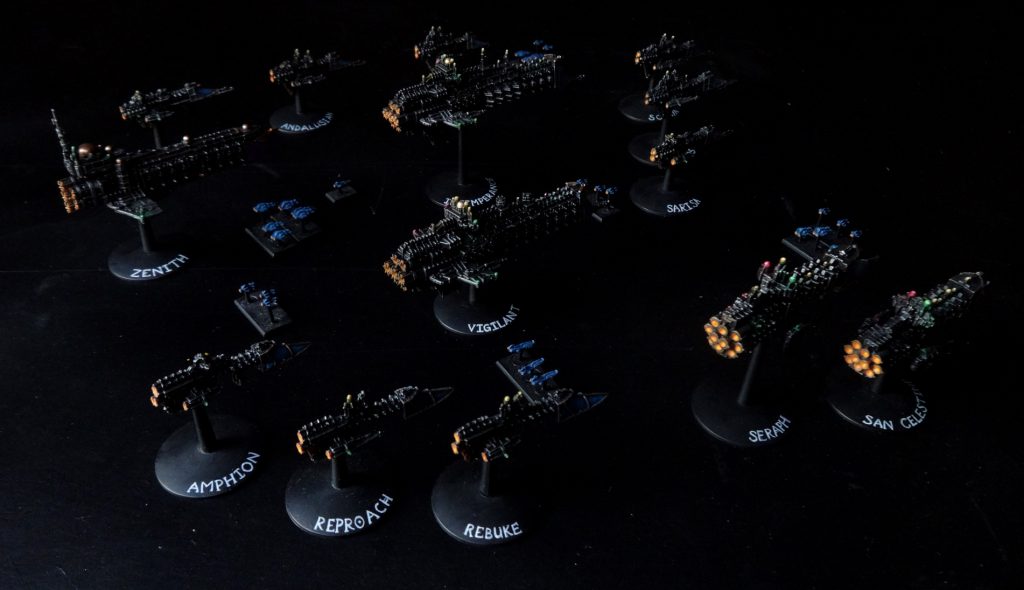
The Imperial Navy Order of Battle
Fleet Construction Rules
Your fleet is built around a core of cruisers. These are your heavy duty work horses, and you’re allowed up to 12 of them, but trust me when I say that any game big enough to involve 12 cruisers will probably take all day to play.
- For every two cruisers in your fleet, you’re allowed one battlecruiser, which is basically the same thing but with longer-ranged guns and a dorsal weapon system.
- For every three battlecruisers/cruisers, you’re allowed one battleship, which means you can usually only afford one of these bad boys, it’s probably going to be your flagship, and you could kill someone if you threw it at them hard enough because it is a giant lump of metal.
- You can have as many escorts as you like, and in certain contexts you might even want to blow a lot of your points on these little guys. See the section on escorts below for why.
Emperor Class Battleship (Capital)
This thing has a bunch of weapons batteries, but that isn’t its raison d’être. It’s primarily a super carrier, with twice the carrier capacity of a cruiser-sized chassis. Swapping out the reinforced frontal armour of most Imperial Navy ships in exchange for a pile of sensors, this thing gets a +1Ld bonus and a giant sign painted on the side that reads “ADMIRAL GOES IN THIS.” Sit well behind your line ships and send giant waves of bombers to wreck enemy capital ships, assault boats to overwhelm enemy escorts, and fighters to screen all your stuff. It’s an incredible utility ship.
Retribution Class Battleship (Capital)
This is your classic battleship right here. If a cruiser started imbibing whey protein and ranting about gains, this is where it’d end up: 50% more firepower, 50% more hit points and 100% more range in exchange for an oil tanker’s turning circle and enough points to buy two whole cruisers. Whether the investment is worth it will depend on your play style, but there’s no denying that this thing looks badass as hell and will make all nearby cruisers develop sudden erectile dysfunction.
Mars Class Battlecruiser (Capital)
If the Emperor class battleship is the ultimate Imperial support ship, this is an extremely close second. You’ve got a much less durable cruiser chassis and half the carrier capacity, but, you have a nova cannon and long-ranged guns. If you’re good at guessing ranges, this is a glorious vessel.
Overlord Class Battlecruiser (Capital)
Long range firepower is a rarity in the Imperial Navy, which makes the Overlord a nifty option. Twice the normal range, and a cheeky little dorsal lance battery. The long range weapons batteries are particularly bad news for Eldar ships, as it’s much harder for them to escape your guns, and those pesky 2+ holofield saves won’t work against the indiscriminate barrage of a weapons battery.
Lunar Class Cruiser (Capital)
This is the most well-rounded workhorse cruiser available to the Navy, sporting an even mix of weapons batteries, lances and torpedoes, meaning it has a way of responding to pretty much any threat (although like any cruiser it’s vulnerable to enemy bombers). It’s a rare Imperial fleet that doesn’t have at least one of these guys, and in bigger battles you might even have a squadron of them. For added sauciness, two of the Lunar class cruisers in your fleet can swap out their prow torpedo tubes for a nova cannon. Whether this is an upgrade or not depends very much on your aptitude for guessing ranges, particularly since torpedoes are generally less swingy (and potentially brutal when fired at a conga line of enemy ships).

Tyrant Class Cruiser (Capital)
Are you jealous of the way the Chaos fleet is full of long-range weapons? Would you like the bargain basement Imperial equivalent? This is the ship for you! Less punch, more range. Just remember that whenever you’re firing over 30cm the effectiveness of your firepower is reduced even more, which sort of hoofs the poor Tyrant right in the effectiveness gonads, but there are some edge cases where an enemy with weak armour that you want to keep at arm’s reach might fear them.
Dominator Class Cruiser (Capital)
This ship was pretty much designed as a nova cannon delivery system, but it also brings some solid broadside weapons batteries to the table that can offer sir or madam some significant punishment once the lines have joined. Of course, weapons batteries don’t do well against 6+ armour, so if you can, make sure you’re sending this thing up against the right foe.
Gothic Class Cruiser (Capital)
Would you like to skip the gunnery table entirely? Fed up with your opponent’s pesky 6+ armour? Yes? Then here’s a giant pile of lances. Sure, your maximum potential shot output is lower than other Imperial cruisers, but the reliability is pleasing. This is very much a specialist ship that does well against heavily armoured targets (particularly Astartes ships), but will struggle to give you the rate of fire to deal with shoals of escorts.
Dictator Class Cruiser (Capital)
This is your most affordable carrier. Most fleets need at least one carrier as a means of screening against enemy bombers, assault boats and torpedoes. The potential damage output is also pretty outrageous; a big wave of bombers can cripple enemy capital ships, and assault boats make short work of escorts. As such, the dictator is a great support ship with enough firepower of its own to contribute to the efforts of other nearby vessels.
Dauntless Class Light Cruiser (Capital)
Fly like an escort, sting like… several escorts. A cruiser with the capacity for 90° turns is no joke, and it’s affordable too. Surprise the everloving Jesus Quintana out of your opponent by issuing Come to New Heading and flipping a 180° just because you can. This thing can zip around with a formation of escorts and be a real pain for the enemy to deal with. The trick is to remember that unlike normal cruisers, its prow weapons are its biggest assets, while its fickle broadside batteries really are a pleasing extra that needs to be firing alongside other friendlies to be relevant.
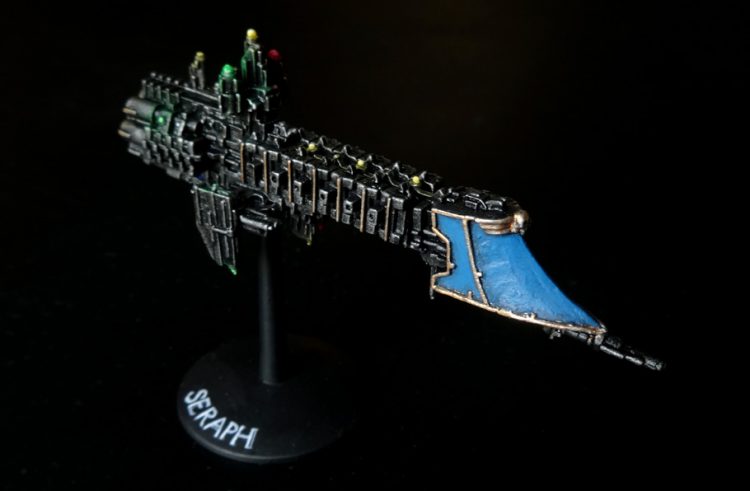
Sword Class Frigate (Escort)
Ah, yes. The AK-47 of the escort world. Good manoeuvrability, and extremely user-friendly guns that can shoot in any direction but aft. Park a squadron of these bad boys near (or ideally behind) a problem and be impressed as three little frigates combine their guns to produce a Firepower 12 salvo – that’s the equal of a cruiser’s broadside – right up your opponent’s jacksie. As with all escorts the major weakness is staying power, and of course being weapons batteries they won’t do well against heavy armour, and you’ll need to make sure you’ve lined them up well so that you’re shooting targets that are closing or moving away. Like any all-rounder in BFG, you’ll find these guys easy to use from the get go, but veteran players will be able to really multiply their effectiveness with good positioning. Thanks to its insane coverage, it’s one of the best ships for dealing with pesky Eldar: flood the battlefield with cheap frigates and stroke your space-beard while callously muttering the phrase “acceptable losses.”
Firestorm Class Frigate (Escort)
The frigate chassis is just big enough to have a giant lance strapped to it, which can only fire forward, but offers you an extremely manoeuvrable way to deal with heavy armour. They also have a cheeky little weapons battery with half the potency of a Sword class frigate. Since the lance can only fire forwards, these are a little trickier to use than the Sword but contextually a great utility. Extremely useful against heavily armoured Orks, almost useless against Eldar.
Cobra Class Destroyer (Escort)
A pair of torpedo tubes strapped to some engines, these things do technically have some weapons batteries, but they’re so small you’re really here to shout FIRE ZE MISSILES. Remember that ships in base to base contact can combine their salvos so that the enemy defence turrets only get to fire at them once, or alternatively fire them separately so that the enemy will use up more of their fighter screen dealing with them. You can fire a volley or two in the early stages to tempt the enemy into dodging them, and then later on, use the cobra’s zippy zippy speed to get around the enemy’s flanks and then fire torpedo salvos straight down their line, meaning that if any torpedoes miss the first vessel they approach, they might well fly straight into any targets beyond it. Just don’t give the enemy too many chances to shoot these things, because a stiff breeze will send them straight to Davey Jones’ Singularity.
The Chaos Fleet
Why You Should Play Chaos
The Chaos fleets have a sweeping grandeur all their own – which is fitting since they’re all ancient Imperial designs. A well painted Chaos fleet looks stunning on the board and the addition of marks or (later) daemon ships really add some punctuation to the aesthetic. The fleet itself is fast and hits at great range – ruining Imperial supply lines and strong points before they even have the opportunity to respond. The Chaos fleet are also incredibly versatile and can bring a lot of different options to the fight that best meet match opponents – capable of bringing an overwhelming array of assault boats or gun batteries or lances. However, the Chaos fleet is notably short on torpedoes and overall has a lower armor class rating than Imperial or Ork fleets – but that’s okay because they can bring some of the coolest and most devastating ships in the game – including the Planet Killer (next article) or the activated Blackstone Fortresses. They’re an excellent fleet to exercise your sea legs and learn the mechanics.
What’s Different about Chaos Fleets?
The Chaos fleet is at first very similar to the Imperial fleet with a wide range of cruiser, heavy cruiser, and battlecruiser options, that allow for even heavier grand cruisers and battleships – hulls and speeds are similar though the Chaos fleet is slightly faster. However, the Chaos fleet stands out in some big ways; first the lack of an armored prow on its ships, second the longer range armament on its beams, and finally the proliferation of lance batteries. In practice this means that while the Imperium is often seeking to close, smash through the lines, and then deliver heavy broadsides at close range – the Chaos fleet in contrast will often use its slight edge in speed to ‘kite’ enemy fleets and while using long range beam and dorsal lances to cripple enemy vessels before moving in for the kill.
Similar to the Admirality of the Imperium, any Chaos fleet of 750 points or larger is required to take a Chaos Warmaster who has different leadership levels depending on the investment. However, unlike the Imperial fleet, the Warmaster can be supplement by up to three Chaos Lords who grant a decent leadership 8, but more importantly grants access to Marks of Chaos that can benefit the ship or fleet. A Chaos Lord may pay to take only a single Mark of Chaos, while the Warmaster may pay for up to four marks and may gain additional benefits for taking the Mark of Khorne. The marks are as follows:
- Mark of Khorne – Doubles the boarding value of the ship. In addition, the Warmaster’s ship adds +1 to critical damage rolls during a boarding action
- Mark of Tzeentch – Grants an extra re-roll
- Mark of Nurgle – The ship gains a hull point and may not be boarded
- Mark of Slaanesh – All enemy ships within 15cm suffer a -2 leadership debuff
The marks allow for vessels to be tailored to some specific operations at an individual or fleet level, however, in practice Tzeentch and Nurgle are most commonly found amongst fleets seeking to maintain their distance from the enemy before they are prepared to overwhelm.
The Chaos Order of Battle
Chaos fleet construction is very similar to Imperial fleet construction – which makes sense given that Chaos fleets are largely 30k era Imperial fleets. Which is great because that means I can just copy/paste from Charlie.
- For every two cruisers in your fleet, you’re allowed one heavy cruiser
- For every three cruisers/heavy cruisers, you’re allowed one grand cruiser or battleship
- You can have as many escorts as you like
Generally speaking, the Chaos vessels all carry some specialty of weapons batteries, lances, or hanger space with some all-purpose vessels mixed in. There is a lot of similarity between the cruiser classes and the larger vessels, with the key difference being that the heavy cruiser classes and higher tonnages all mount additional dorsal weapons, generally lances.
Despolier Class Battleship (Capital)
The Despoiler battleship is very similar to the Imperial Emperor class battleship across its stat lines and includes a similar hanger capacity for 8 wings of attack craft, however, like many Chaos ships, it sports a much larger lance battery armament. With a moderate sized, long-ranged weapon battery emplacement on either beam, the Despoiler adds a devastating quad-set of lance batteries on the prow – though short ranged at 30 cm, it adds a dorsal set of three more lances at 60 cm that makes it an extreme stand-off threat, capable of encircling enemy vessels at a great distance while launching fighter and bomber wings and plugging away at escorts, or light vessels with its long-ranged lance and weapon batteries or bring a monstrous seven lances to bear on any vessel brave enough to close with the vessel.
Desolator Class Battleship (Capital)
As far as battleships go, the Desolator is an extremely cost efficient lance platform that is fast for a battleship – matching the top speeds of most enemy cruisers. Weighing in at 300 points, the Desolator packs a quad set of lances on each beam capable of engaging enemy vessels at 60 cm, and adds an additional set of medium weapons batteries on the dorsal line, as well as a set of 9-strength torpedoes on the prow. The Desolator is built to similarly stand off and force enemy vessels to close as it plucks away with impunity outside of the enemy’s engagement range – and if you already have the carrier capacity in your cruiser selections, the Desolator makes for a steal of a battleship.
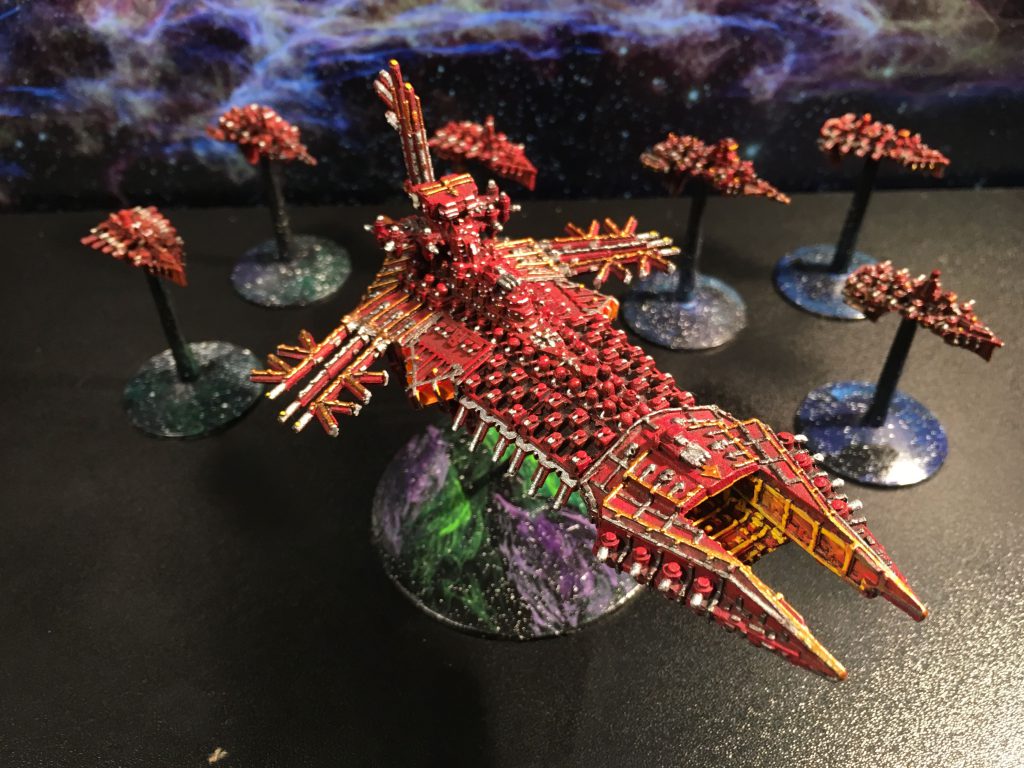
Repulsive Class Grandcruiser (Capital)
The Repulsive is similar in design to the Desolator class battleship but instead of mounting port and starboard lance batteries it mounts a high-strength, moderate ranged (45 cm) weapon battery. The dorsal lance battery is still a three-set, but its half ranged at 30cm and the prow torpedo tubes are downsized to a more standard 6-torpedo spread. It’d be a bargain at 230 points, but the Repulsive may struggle to maintain pace with the rest of the fleet and its shorter ranges, even at 45 cm, may limit its capability to maintain seperation.
Styx Class Heavy Cruiser (Capital)
The Styx is commonly a mainstay of Chaos fleets – carrying a spacious hanger for 6 squads and a dorsal lance and prow weapons battery armament capable of reaching out to 60 cm it perfectly aligns with the nature of the Chaos fleet while providing significant ordnance capacity, however the Styx does not come cheap at 275 points.
Hades Class Heavy Cruiser (Capital)
The Hades carries a medium strength, moderate-ranged weapon battery loadout on the beams with two long-ranged dorsal lances and a dual prow lances. It’s an all-purpose heavy cruiser that brings some extra dakka for engagement of Eldar fleets.
Acheron Class Heavy Cruiser (Capital)
The Archeron is like an upgunned Gothic class cruisers – with long-ranged port and starboard lance batteries it adds an additional dorsal set of lances with a lesser 45cm range and a 45cm lighter strength weapons battery.
Devastation Class Cruiser (Capital)
The Devastation is a smaller version of the Styx but with a still formidable four capacity hanger. If you’re looking to mount heavier weapons in place of carrier capacity at the higher levels, then this is the perfect cruiser for you.
Murder Class Cruiser (Capital)
The Murder is the smaller version of the Hades and helps amplify your weapon battery capabilities at range. It includes a set of prow lances and it is a solid cruiser complement to your fleet in engagements vs Eldar vessels, but for dedicated engagements vs Eldar you may want to look at the Carnage or Slaughter class instead.
Carnage Class Cruiser (Capital)
The Carnage is a slightly different version of a Murder class that adds a range increase up to 60 cm on some of its weapon batteries for a slight bump in cost. However, it additionally exchanges the prow lances for a long ranged, low strength weapon battery that can amplify its port and starboard guns.
Slaughter Class Cruiser (Capital)
The Slaughter is a bit of an oddity in the Chaos fleet. It’s a cheap cruiser, but unlike the rest of the fleet, it maxes out its weapon ranges at 30 cm. However, it’s a fast vessel capable of moving as fast as any escort in a single move, and additionally gains extra movement under an All Ahead Full special order. While it sports a set of lances on either beam that may not be as effective against Eldar vessels, the Slaughter does have a strong set of weapons batteries on the beam and prow weapon battery. Despite the short range, the Slaughter has the speed and firepower to take the fight to the Eldar.
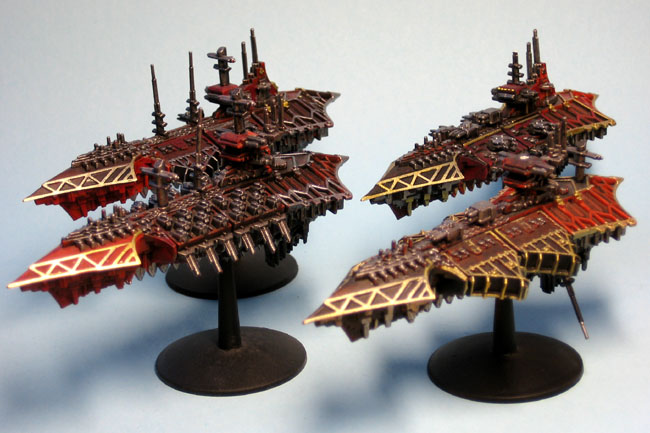
Idolator Class Raider (Escort)
Like all Chaos escorts, the Idolator is speedy at 30cm of movement and mounts a light weapon battery and a single lance. Interestingly, the Idolator does not suffer any range penalties for firing the weapon battery over 30 cm, so despite the relatively low strength, a squadron can still output a significant level of gunnery fire at arms length.
Infidel Class Raider (Escort)
The standard torpedo boat. The Infidel also comes with a light weapons battery but it does not have the range of the Idolator. However, Chaos fleets unlike Imperial fleets, do not have wide access to torpedoes, and the Infidel does bring some added versatility in this regard.
Iconoclast Class Destroyer (Escort)
Cheap and fast – the Iconoclast is both lightly armed with a short-ranged weapon battery, but also lightly armored with Eldar levels of paper-thin plating. In groups it can pack a significant punch, but you may be better off looking to the other escorts for your fleet’s needs.
Eldar Corsairs

Why You Should Play as the Eldar
Anyone who has ever had the privilege of playing with or against Eldar (Aeldari) knows that they’re about to pull some shit that breaks the normal rules of the game, and boy, do Eldar in BFG bring it in spades.The Eldar are an exceptionally fast fleet on the table and excel at hit and run attacks that leave behind flaming wrecks in their space wake as they hide from any retaliation. They have some of the strongest weapons and ordnance in the game, and their escorts are all individually and uniquely powerful when combining their armament with their maneuverability. As a fleet, they are also one of the most reliable from a leadership perspective and the capability to deliver special orders across the fleet. However, true to the lore, they can fold quickly if caught out and for that reason the fleet will be unforgiving to mistakes. If you like a bit of a challenge and cries of cheese from opponents who cannot catch your ships (but utterly delight when they do), then Eldar is the fleet for you!
What’s Different about Eldar Corsairs
Everything.
First off, the Pirate Prince (leader) grants a huge +2 leadership bonus and all Eldar ships otherwise get a +1 leadership bonus – this means that your flagship will start the game at leadership 9, at minimum. This helps Eldar fleets operate far more reliably in certain terrain elements, in issuing special orders to the fleet, and taking certain command checks. All Eldar ships are also equipped with Holofields instead of the standard shield – these provide Eldar ships with a 2+ save against successful hits against all forms of weapons, ordnance, and even many special abilities like boarding attempts. The only exception is weapon batteries – instead weapon batteries receive a debuff that lowers the number of shots an enemy ship can take on the Eldar ship. That is frustrating sure, but the true beauty of the Eldar bullshit is that they may move TWICE in the player turn (movement and ordnance phases) and may turn in any direction before doing so. I say may, because Eldar ships, unlike other ships, may simply choose not to move at all. To truly understand how devastating this movement advantage can be, you must watch, powerless, as a group of Eldar escorts dance out of an asteroid field, drop a barrage of lances and torpedoes into your Cruisers, then pull a 180 and dive right back into that asteroid field unscathed and untargetable. Eldar bullshit. I love it.
But wait, there’s more! Eldar armaments are also suitably special – their lance batteries (Pulsars) may score additional hits for each successful hit (which can be devastating when combined with a ‘Lock On’ special order) and their weapon batteries will always count an enemy vessel in the most advantageous targeting aspect on the gunnery table. Furthermore, Eldar Ordnance also has significant advantages – their torpedoes can only be destroyed on a ‘6’ by defensive turrets and may automatically re-roll the result for any torpedoes that miss their target making them the best torpedoes in the game. Similarly, Eldar bombers also require a ‘6’ to be hit by enemy defensive turrets and may re-roll the number of attacks each squadron may make. Finally, fighters squadrons have a 50/50 chance to remain on the board following a successful intercept of enemy ordnance.
That said, there are significant drawbacks to all these boosts. All Eldar ships have a lower armor rating and fewer hullpoints making them susceptible to rapidly taking damage and becoming crippled. There is also a 50% chance to cause critical damage to Eldar ships with each point of damage they sustain which can rapidly deteriorate their capabilities. The range of their weaponry, across the fleet, is among the shortest in the game and their most significant strength, their mobility, may be greatly hindered by poor positioning. When effectively managed, they are the fastest ships in the game, but a savvy opponent can maneuver and force an Eldar player into a position where they cannot take advantage of their speed. This is because Eldar ships have three profiles based on their relation to the ‘sunward edge’. Putting an Eldar fleet in a position where they cannot effectively capture the solar winds leaves them open to counter weapon battery fusillades that will utterly cripple or destroy the fleet. Unlike shields used by other races, the holofields that are so effective at stopping non-weapon battery fire, do not actually protect the ship from things like blast markers, explosions, or gas clouds – which means that even basic phenomena can force attrition on Eldar vessels where a single point of damage can often have cataclysmic cascading effects. Finally, Eldar vessels, pirate princes, and rerolls are expensive especially among the Cruiser classes.
The Eldar Fleet Order of Battle
The Eldar fleet roster is rather sparse with only two cruiser classes and four escort classes – however, with the nature of their play style and their ship configurations they are actually fairly dynamic and you won’t really regret your lack of options. There are expansion options for Eldar fleets but we’ll discuss those more in the next article. Unlike other fleets, the longest range of any weapon in this list is 30 cm – meaning that the Eldar are required to be close where they are at risk for return fire. For that reason you will always want to keep yourself at max range, be aware of where your opponent MUST move, what their max range is for the target vessel and also any supporting vessels, where your escape lines are, and what phenomena can help you.
To avoid the devastating return fire, Eldar fleets like to hunt and pick off stragglers or snipe with ordnance before lining up a killing blow – often with a Lock On assist that will prevent any turns during their movement but result in an extremely effective strafe through the enemy battle line. In order to do so, Eldar Corsair fleets are commonly heavy on escort sized vessels that are exceptionally fast and reliable but also purpose built to a singular role to either disrupt, harass, or give that final blow to an enemy vessel.

Eclipse Class Cruiser (Capital)
The Eclipse cruiser is the ‘carrier’ of the Eldar fleet. It is equipped with four launch bays and two of the hard-hitting Pulsars and can be extremely fast at a top-speed of 25 cm per movement – meaning that you’ll double the speed of most enemy capital ships and even many escorts. One of the big advantages of the Eclipse’s speed is that your bomber wings will be able to launch and close on enemy ships without risking intercept from fighter screens while delivering a solid barrage with the twin Pulsars before slinking away to safety after launch. However, these advantages will come at a significant premium, as this Cruiser is expensive at 250 points. In taking an Eclipse, it’s more likely that you will use it in a defensive role to launch ordnance screens for your destroyers and frigates.
Shadow Class Cruiser (Capital)
If the Eclipse is the carrier of the Eldar fleet, then the Shadow is the gunship, and it’s a real bruiser. Armed with a very heavy strength Eldar weapon battery on the prow and a solid 4-tube torpedo bay on the keel, the cruiser can lay down a formidable spread of firepower at range and in close. With the same speed profile as the Eclipse, the Shadow can utilize its torpedoes to break up enemy formations and allow your escorts to pick off enemy ships that find themselves alone, or bolster an attack run by launching point blank while the weapon batteries pound away. While expensive at 210 points, the Shadow is a must-take in your roster for its sheer capability against almost any enemy vessels, but also as a hard counter to mirror match Eldar fleets where your Pulsars, Torpedoes, and Bombers won’t break past the holofields.
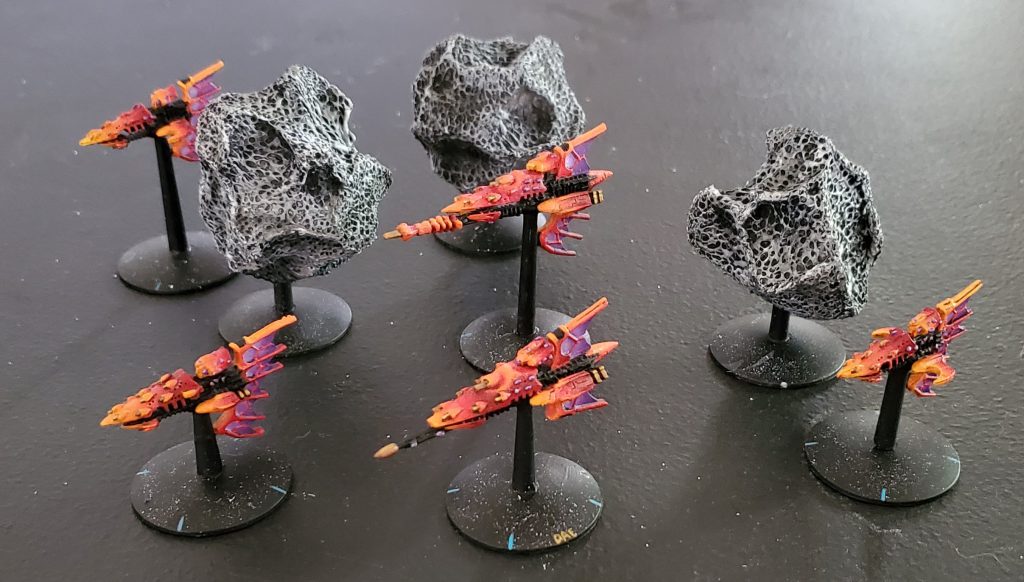
Hellebore Class Frigate (Escort)
The Hellebore is a bit of an oddity in the Eldar fleet – it’s an all-purpose gunboat. The most heavily armed escort in the Eldar line of battle and probably of any escort in the galaxy. It touts an impressive armament of a single Pulsar, a single weapon battery, and a dual torpedo tube – all while maintaining the exceptional 30 cm top-speed of all Eldar escort vessels. A single Hellebore has enough firepower to cripple most cruiser-class vessels while a full squadron can can devastate even the largest enemy vessels. That said, you will pay for the capability with their 65 points price tag (75 under the original book) which can prove costly should you lose one to space phenomena due to your lack of shielding.
Aconite Class Frigate (Escort)
The Aconite is almost as heavily armed as the Hellebore, but it instead sacrifices the variety of weapons for high strength weapon batteries. On its own, it a single Aconite can provide an impressive amount of gun support, but when squadroned with other Aconites, escorts, or even a Shadow cruiser, the weapon battery can quickly overwhelm an enemy and leave them in a floating hulk with a single pass. Like the Shadow, I consider this a must in the fleet – while they are expensive, slightly less so than the Hellebore at 55 points (65 in the original book) – they will immediately amplify the power of other vessels in the squadron and punch well above their weight.
Nightshade & Hemlock Class Destroyers (Escort)
The two destroyer options are the cheapest of the Escort options at 40 points each and will likely comprise a significant percent, if not the majority, of your fleet. While the Nightshade carries a dual-torpedo tube and a single weapon battery, the Hemlock carries only a single Pulsar. As such, the Nightshade is purpose built to disrupt enemy formations by laying down either large torpedo spreads or moving in for the attack and coordinating a single torpedo blitz. Likewise, the Hemlock only has one role – when the time is right Lock On, dive in, and utterly wreck whatever it’s targeting with the Pulsar.
Ork Pirates
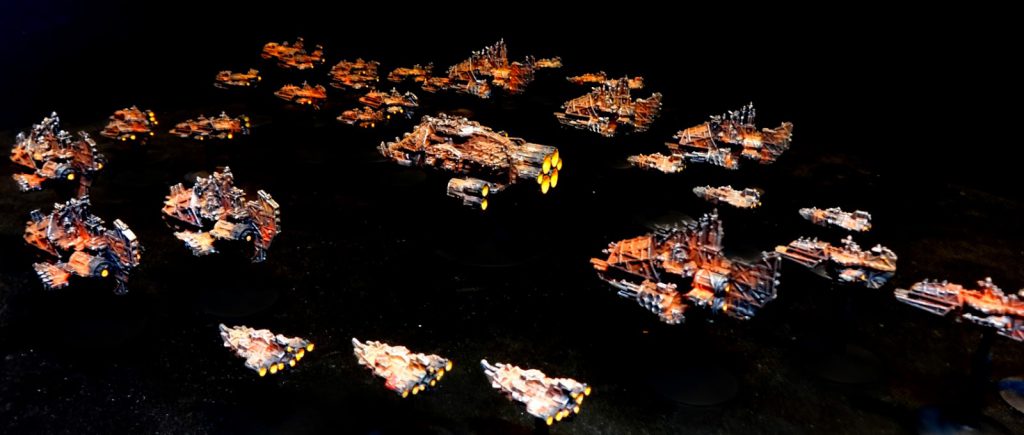
Why You Should Play as Orks
I thought about writing out a long, well articulated reason for why you should just have a blast with the guys – but frankly this video captures it so much better than I ever could. Seriously it’s perfect.
What’s Different about Ork Pirates
The Ork fleet is formed up of a suitably rag tag group of ships that suffers from a lot of the variability that is iconic of GWs early 90s-era games. While Eldar receive a universal leadership bonus, Orks suffer a universal leadership debuff, -1 across all ships and squadrons that can make an Ork fleet rather unpredictable and unwiedly to manage. This is offset somewhat by being able to take multiple Warbosses across a fleet which may provide additional rerolls cheaply, as well as providing additional benefits to boarding actions, weapon buffs, shield enhancements, or damage control buffs. Orks receive a significant benefit in that they will always pass a leadership check for All Ahead Full special orders although the speed boost is halved. While Ork cruisers are a bit ponderous, this does make them at times surprisingly fast, and Ork escorts can be downright speedy as they open palm slam that big, shiny, red ‘ere we go’ button on the bridge.
That speed is essential, because the biggest strength of the Orks is in their ability to close, ram, grapple, and then board opposing vessels as all Ork vessels have strong frontal armor and gain a bonus to boarding that can be boosted by the Warbosses. It is worth mentioning that Orks do not have lance batteries in their core fleets but they do have strong but variable and short ranged weapon batteries. The heavy gunz are probably the most fearsome, inflicting double damage for each successful hit- however, they have a mere 15 cm range while the rest of the fleet carries mostly 30cm range gunz batteries. The Orks Fighta-Bombaz are a combination of both Fighters and Bombers, able to perform either roll but may only make half the normal number of attack runs that traditional bombers may make. They also trade a middle ground of speed, making them faster than normal bombers, but slower than normal fighters. Torpedoes are also highly variable, with their strength being randomly determined like the gunz. Each Kroozer has the option to replace their prow batteries with launchers but other than the option to purchase boarding torpedoes, the Ork torpedoes are otherwise standard.
With the Orks, the name of the game is to swarm, rush in, and bash things up close or in combat – and frankly, I cannot think of anything more Orky.
The Ork Fleet Order of Battle
Like the Eldar Corsair list, the Ork Pirate list is a bit sparse but receive several expansionary vessels that we’ll discuss in the next article – including the most iconic of vessels, the Ork Hulks and Roks. However, the core list is both versatile and contains powerful escort options. Forming the backbone are cheap cruiser options with robust hulls matching that of the Grand Cruisers of the Chaos or Imperial fleets, though not nearly as well shielded.
Kill Kroozers (Capital)
Cobbled together from the ruined remains of ships and other space junk, Kroozers are hulking weapon battery platforms – slow moving at a top speed of 20 cm (ignoring the All Ahead Full), they are resilient with 10 hit points (vs the standard 8 for a cruiser, or 6 for Eldar) though they sport only a single shield. They are armed with an assortment of guns and heavy gunz on the beams and bow of the vessels and are entirely made to smash into the enemies formation, unleashing volleys in all directions, before slamming into a ship and destroying from the inside by sending combat hungry Orks rampaging through its innards. At 155 points, these are sturdy ships to anchor the fleet.
Terror Ships (Capital)
A variant of the Kill Kroozer, the Terror Ship brings launch bays at the expense of the port/starboard heavy gunz. Acting as the carrier for the Ork fleet, the Terror Ship still brings all the fearsome capability in closing and boarding of the Kill Kroozer, but pays a slight premium at 185 for the launch bays.

Onslaught Attack Ship (Escort)
Like all Ork escorts, the Onslaught Attack Ship has a heavily armored prow but weak armor on the beams and stern giving it an advantage in a head-on situation but can fold quickly if the enemy can maneuver alongside or behind. The Onslaught carries a decent, if highly variable, weapon battery but taken in squadrons, can average a heavy, devastating volley of gun fire.
Savage Gunship (Escort)
This is probably the hardest hitting of any Ork escort – armed only with a high strength battery of Heavy Gunz, the Savage will tear apart any vessel it can close in on – and woe be to any Eldar ship that finds itself within the threat range of these. More importantly, there is no variability with the Savage eliminating a lot of the risk that comes with other Ork escorts.
Ravager Attack Ship (Escort)
Another interesting choice for an Ork escort – the Ravager is a torpedo boat with a small strength weapons battery. While the torpedo spread from the Ravager is variable, and Ork squadrons cannot combine their torpedo salvoes, a single Ravager is capable of delivery a spread larger than many of the capital ships in the game. This is great for either breaking up or trying to ‘steer’ enemy formations to keep enemy ships where you want them – the big risk with Ravagers is the leadership downside and attempting to pass special orders to reload your torpedo tubes.
Brute Ramship (Escort)
Close your eyes for a minute and imagine the most orky possible ship – did you think of a ridiculous, misshapen, cobbled together wedge of steel with giant engines whose sole purpose is to drive itself as fast as possible into an enemy ship? Because that is what this is – and it is fantastic. Like all escorts it sports a heavily armored prow, but it also gains a special rule upon ramming where it can inflict a lot of potential damage – hitting WAY above its weight class and making it a threat against even the largest capital ships. Unfortunately, it is probably also a suicide mission but that’s perfectly okay- because these bad boys are dirt cheap at 25 points. It also has a small weapons battery, but who cares about that, go drive into something.
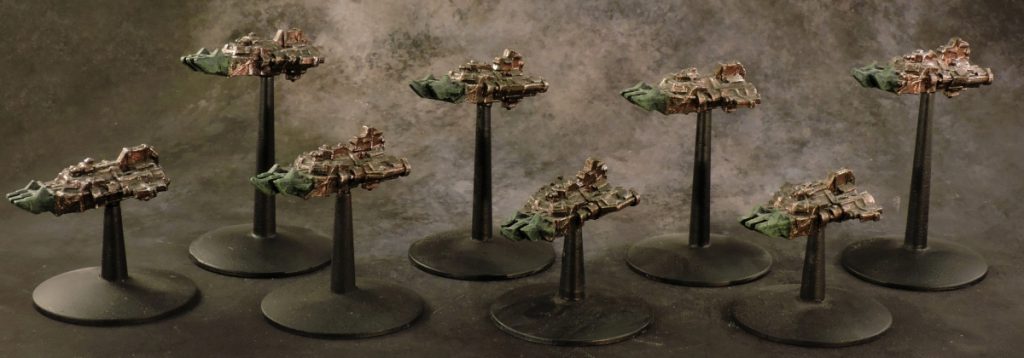
Final Notes
That wraps up the core fleets in BFG – in the next article we’ll dive into the expansion that really brought diversity and a lot of depth to the game, Battlefleet Gothic: Armada. We’ll introduce the Necrons, Tau, Dark Eldar, Tyranids, and Space Marine fleets and then a slough of expansionary vessels and rules for the core fleets that bring a ton of new variety to the table.
